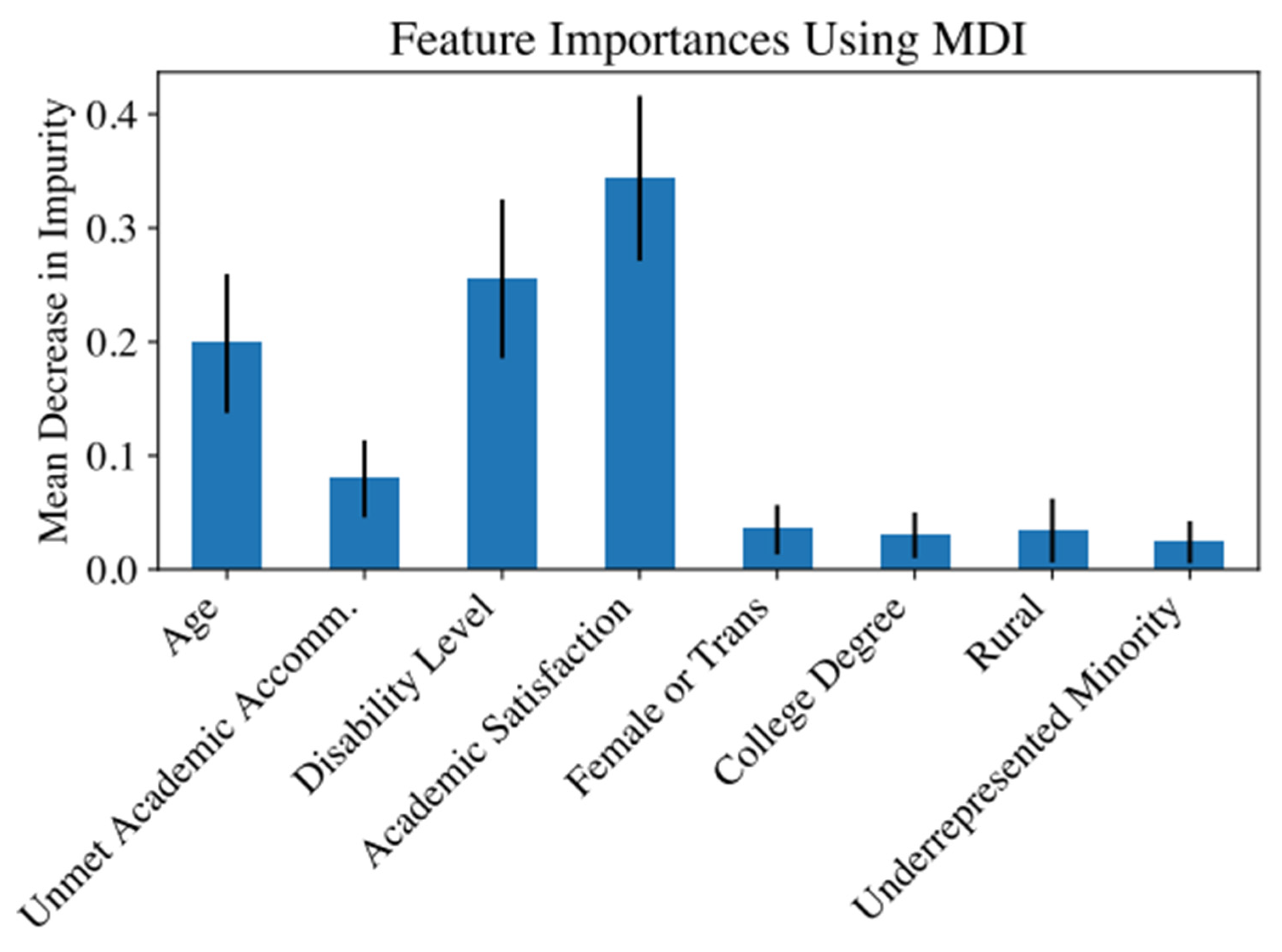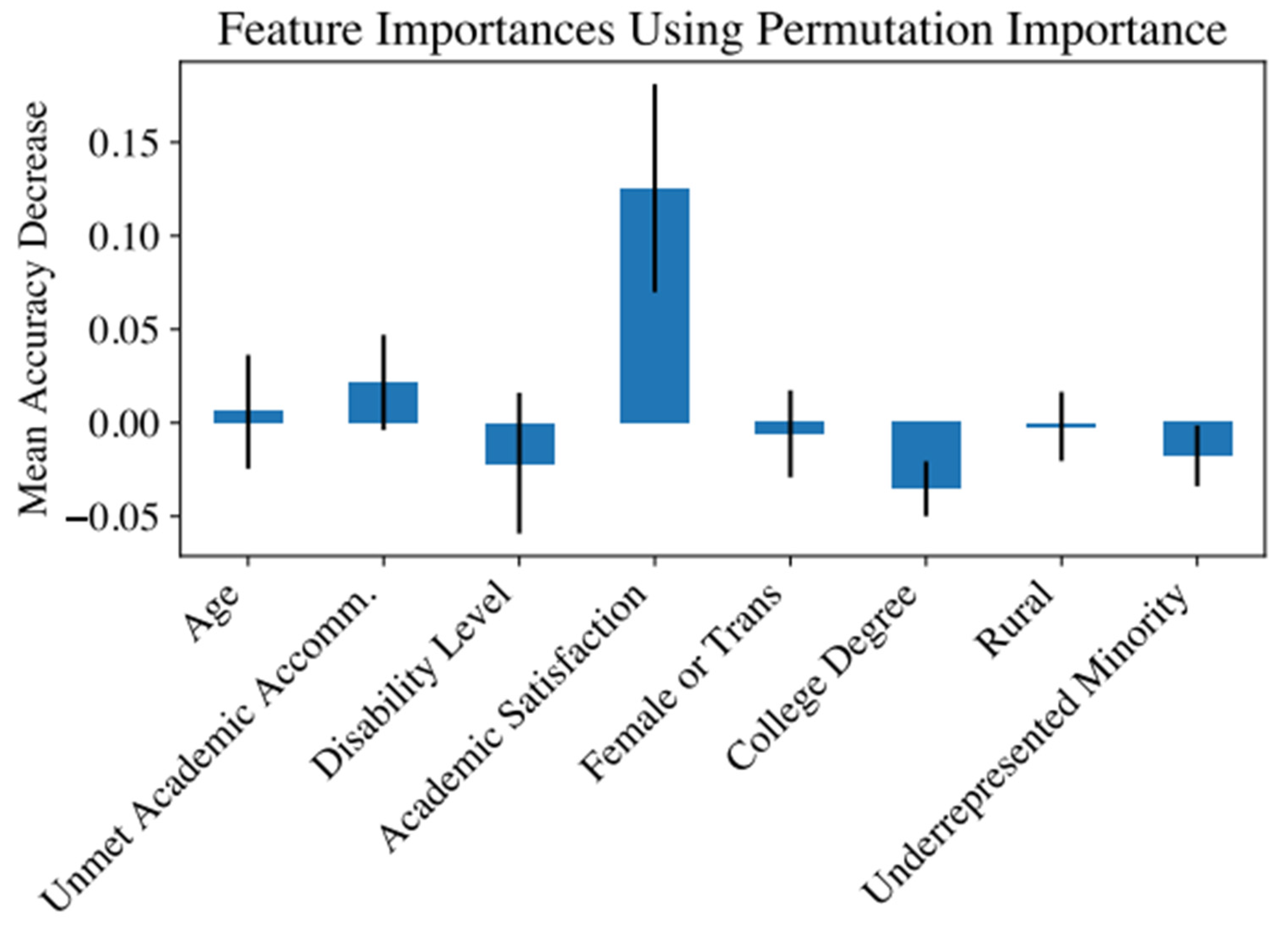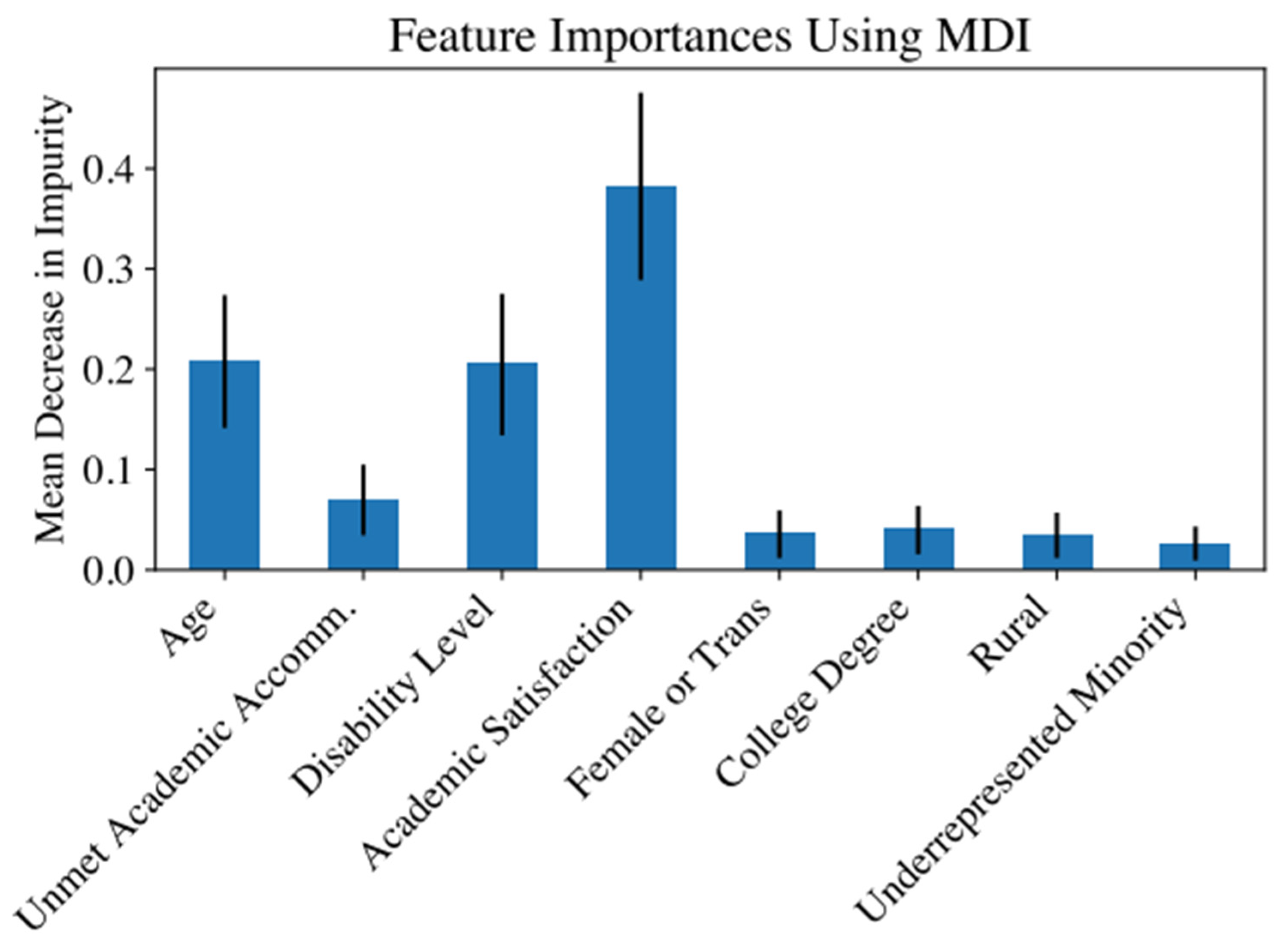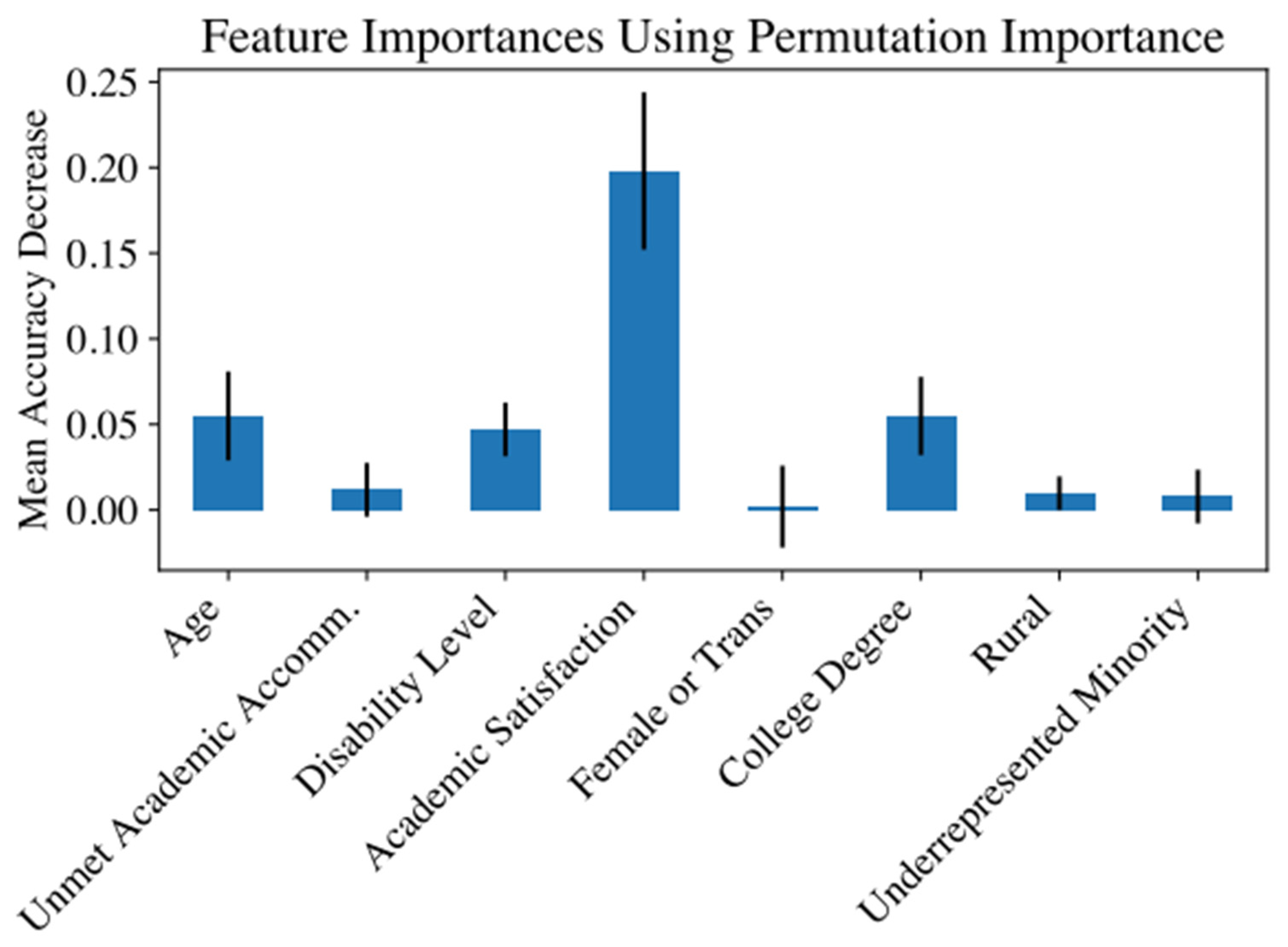Using Machine Learning to Identify Educational Predictors of Career and Job Satisfaction in Adults with Disabilities
Abstract
1. Introduction
1.1. Workforce Disparities Among Disabled Adults in the U.S.
1.2. Sociodemographic Predictors
1.3. Disability Level
1.4. Academic Satisfaction and Unmet Academic Accommodation Needs
1.5. Purpose of the Current Study
2. Method
2.1. Participants
2.2. Procedure
2.3. Measures
2.3.1. Demographics
2.3.2. Disability
2.3.3. Academic Satisfaction
2.3.4. Accommodations Received
2.3.5. Job and Career Satisfaction
2.4. Data Analysis
3. Results
3.1. Descriptive Statistics
3.2. Random Forest Feature Importance
3.2.1. Job Satisfaction
3.2.2. Career Satisfaction
4. Discussion
4.1. Academic Satisfaction
4.2. Disability Level
4.3. Age
4.4. Unmet Accommodation Needs
4.5. College Degree Status
4.6. Educational Implications for Students with Disabilities
4.7. Limitations and Future Directions
5. Conclusions
Author Contributions
Funding
Institutional Review Board Statement
Informed Consent Statement
Data Availability Statement
Conflicts of Interest
References
- CDC Disability Impacts All of Us Infographic|CDC. Available online: https://www.cdc.gov/disability-and-health/media/pdfs/disability-impacts-all-of-us-infographic.pdf (accessed on 7 June 2025).
- U.S. Bureau of Labor Statistics. Persons with a Disability: Labor Force Characteristics—2024; U.S. Bureau of Labor Statistics: Washington, DC, USA, 2024.
- McDaniels, B. Disproportionate Opportunities: Fostering Vocational Choice for Individuals with Intellectual Disabilities. J. Vocat. Rehabil. 2016, 45, 19–25. [Google Scholar] [CrossRef]
- Schur, L.; Han, K.; Kim, A.; Ameri, M.; Blanck, P.; Kruse, D. Disability at Work: A Look Back and Forward. J. Occup. Rehabil. 2017, 27, 482–497. [Google Scholar] [CrossRef] [PubMed]
- Kulkarni, M.; Gopakumar, K.V. Career Management Strategies of People with Disabilities. Hum. Resour. Manag. 2014, 53, 445–466. [Google Scholar] [CrossRef]
- Villanueva-Flores, M.; Valle, R.; Bornay-Barrachina, M. Perceptions of Discrimination and Distributive Injustice among People with Physical Disabilities: In Jobs, Compensation and Career Development. Pers. Rev. 2017, 46, 680–698. [Google Scholar] [CrossRef]
- Brooks, J.D. Just a Little Respect: Differences in Job Satisfaction Among Individuals with and Without Disabilities. Soc. Sci. Q. 2019, 100, 379–388. [Google Scholar] [CrossRef]
- Dobrow, S.R.; Ganzach, Y.; Liu, Y. Time and Job Satisfaction: A Longitudinal Study of the Differential Roles of Age and Tenure. J. Manag. 2018, 44, 2558–2579. [Google Scholar] [CrossRef]
- Pagan, R. Ageing and Disability: Job Satisfaction Differentials across Europe. Soc. Sci. Med. 2011, 72, 206–215. [Google Scholar] [CrossRef] [PubMed]
- Krause, J.S.; Dismuke-Greer, C.E.; Jarnecke, M.; DiPiro, N.D. Career Satisfaction among Working Age Individuals with Multiple Sclerosis or Spinal Cord Injury. J. Vocat. Rehabil. 2022, 57, 33–40. [Google Scholar] [CrossRef]
- Yasin, Y.M.; Kerr, M.S.; Wong, C.A.; Bélanger, C.H. Factors Affecting Job Satisfaction among Acute Care Nurses Working in Rural and Urban Settings. J. Adv. Nurs. 2020, 76, 2359–2368. [Google Scholar] [CrossRef]
- Li, J.; Roessler, R.T.; Rumrill, P.D.; Ahmed, E.R. Factors Influencing Job Satisfaction for Employed Adults with Multiple Sclerosis. Rehabil. Couns. Bull. 2017, 61, 28–40. [Google Scholar] [CrossRef]
- Okpara, J.O.; Squillace, M.; Erondu, E.A. Gender Differences and Job Satisfaction: A Study of University Teachers in the United States. Women Manag. Rev. 2005, 20, 177–190. [Google Scholar] [CrossRef]
- Pagan, R.; Malo, M.Á. Performance Appraisal and Job Satisfaction for Workers Without and with Disabilities by Gender. Soc. Indic. Res. 2021, 153, 1011–1039. [Google Scholar] [CrossRef]
- Yap, M.; Cukier, W.; Holmes, M.; Hannan, C.-A. Career Satisfaction: A Look behind the Races. Relat. Ind. 2010, 65, 584–608. [Google Scholar] [CrossRef]
- Pattani, R.; Burns, K.E.A.; Lorens, E.; Straus, S.E.; Hawker, G.A. Effect of Race, Gender Identity, and Their Intersection on Career Satisfaction: A Cross-Sectional Survey of Academic Physicians. Med. Teach. 2022, 44, 614–621. [Google Scholar] [CrossRef]
- Goldberg, A.E.; Matsuno, E.; Beemyn, G. “I Want to Be Safe…And I Also Want a Job”: Career Considerations and Decision-Making Among Transgender Graduate Students. Couns. Psychol. 2021, 49, 1147–1187. [Google Scholar] [CrossRef]
- Hojat, M.; Kowitt, B.; Doria, C.; Gonnella, J.S. Career Satisfaction and Professional Accomplishments. Med. Educ. 2010, 44, 969–976. [Google Scholar] [CrossRef]
- Sundar, V.; Brucker, D.L. Personal and Organizational Determinants of Job Satisfaction for Workers with Disabilities. Rehabil. Couns. Bull. 2018, 62, 170–179. [Google Scholar] [CrossRef]
- Moore, M.E.; Konrad, A.M.; Yang, Y.; Ng, E.S.W.; Doherty, A.J. The Vocational Well-Being of Workers with Childhood Onset of Disability: Life Satisfaction and Perceived Workplace Discrimination. J. Vocat. Behav. 2011, 79, 681–698. [Google Scholar] [CrossRef]
- Stålnacke, B.-M. Life Satisfaction in Patients with Chronic Pain—Relation to Pain Intensity, Disability, and Psychological Factors. Neuropsychiatr. Dis. Treat. 2011, 7, 683–689. [Google Scholar] [CrossRef]
- Tan, J.H.; Abdin, E.; Shahwan, S.; Zhang, Y.; Sambasivam, R.; Vaingankar, J.A.; Mahendran, R.; Chua, H.C.; Chong, S.A.; Subramaniam, M. Happiness and Cognitive Impairment Among Older Adults: Investigating the Mediational Roles of Disability, Depression, Social Contact Frequency, and Loneliness. Int. J. Environ. Res. Public Health 2019, 16, 4954. [Google Scholar] [CrossRef]
- Franzen, J.; Jermann, F.; Ghisletta, P.; Rudaz, S.; Bondolfi, G.; Tran, N.T. Psychological Distress and Well-Being among Students of Health Disciplines: The Importance of Academic Satisfaction. Int. J. Environ. Res. Public Health 2021, 18, 2151. [Google Scholar] [CrossRef]
- Mirhosseini, S.; Bazghaleh, M.; Basirinezhad, M.H.; Abbasi, A.; Ebrahimi, H. The Relationship between Depression and Academic Satisfaction in Medical Science Students. J. Ment. Health Train. Educ. Pract. 2020, 16, 99–111. [Google Scholar] [CrossRef]
- Zalazar-Jaime, M.F.; Moretti, L.S.; Medrano, L.A. Contribution of Academic Satisfaction Judgments to Subjective Well-Being. Front. Psychol. 2022, 13, 772346. [Google Scholar] [CrossRef]
- Turan, A.; Tunç, A.Ö.; Göktepe Aydın, E. Explaining Career Satisfaction on the Basis of Alumni Satisfaction, Gap Period and Gender: Evidence from Turkish Higher Education. Asian Soc. Sci. 2015, 11, 229. [Google Scholar] [CrossRef]
- Troiano, P.F.; Liefeld, J.A.; Trachtenberg, J.V. Academic Support and College Success for Postsecondary Students with Learning Disabilities. J. Coll. Read. Learn. 2010, 40, 35–44. [Google Scholar] [CrossRef]
- Walter, O.; Hazan-Liran, B. Psychological Capital, Social Support, and Academic Adjustment of Students with Learning Disabilities: The Value of Institutional Support Centers. Am. J. Health Behav. 2024, 48, 462–470. [Google Scholar] [CrossRef]
- Troccoli, A. Attitudes Toward Accommodations and Academic Well-Being of College Students with Disabilities. Ph.D. Thesis, Rowan University, Glassboro, NJ, USA, December 2017. [Google Scholar]
- Dong, S.; Guerette, A.R. Workplace Accommodations, Job Performance and Job Satisfaction Among Individuals with Sensory Disabilities. Aust. J. Rehabil. Couns. 2013, 19, 1–20. [Google Scholar] [CrossRef]
- CDC Disability and Health Data System (DHDS) Status and Types|CDC. Available online: https://www.cdc.gov/dhds/data-guides/status-and-types.html (accessed on 7 June 2025).
- Tait, R.C.; Chibnall, J.T.; Krause, S. The Pain Disability Index: Psychometric Properties. Pain 1990, 40, 171–182. [Google Scholar] [CrossRef]
- Schmitt, N.; Oswald, F.L.; Friede, A.; Imus, A.; Merritt, S. Perceived Fit with an Academic Environment: Attitudinal and Behavioral Outcomes. J. Vocat. Behav. 2008, 72, 317–335. [Google Scholar] [CrossRef]
- Pianosi, R.; Presley, L.; Buchanan, J.; Lévesque, A.; Savard, S.-A.; Lam, J. Canadian Survey on Disability, 2022: Concepts and Methods Guide; Reports on Disability and Accessibility in Canada; Statistics Canada: Ottawa, ON, Canada, 2023; ISBN 978-0-660-68203-7.
- Brooks, J.M.; Iwanaga, K.; Chan, F.; Lee, B.; Chen, X.; Wu, J.-R.; Walker, R.; Fortuna, K.L. Psychometric Validation of the Job Satisfaction of Persons with Disabilities Scale in a Sample of Peer Support Specialists. Psychiatr. Rehabil. J. 2021, 44, 93–98. [Google Scholar] [CrossRef]
- Seibert, S.E.; Kraimer, M.L.; Holtom, B.C.; Pierotti, A.J. Career Satisfaction Scale [Database record]. APA PsycTests 2012. [Google Scholar] [CrossRef]
- Breiman, L. Random Forests. Mach. Learn. 2001, 45, 5–32. [Google Scholar] [CrossRef]
- Strobl, C.; Boulesteix, A.-L.; Zeileis, A.; Hothorn, T. Bias in Random Forest Variable Importance Measures: Illustrations, Sources and a Solution. BMC Bioinform. 2007, 8, 25. [Google Scholar] [CrossRef]
- Nicodemus, K.K.; Malley, J.D.; Strobl, C.; Ziegler, A. The Behaviour of Random Forest Permutation-Based Variable Importance Measures under Predictor Correlation. BMC Bioinform. 2010, 11, 110. [Google Scholar] [CrossRef] [PubMed]
- Szymczak, S.; Holzinger, E.; Dasgupta, A.; Malley, J.D.; Molloy, A.M.; Mills, J.L.; Brody, L.C.; Stambolian, D.; Bailey-Wilson, J.E. r2VIM: A New Variable Selection Method for Random Forests in Genome-Wide Association Studies. BioData Min. 2016, 9, 7. [Google Scholar] [CrossRef]
- Ziegler, A.; König, I.R. Mining Data with Random Forests: Current Options for Real-World Applications. WIREs Data Min. Knowl. Discov. 2014, 4, 55–63. [Google Scholar] [CrossRef]
- Felsenfeld, S.; Broen, P.A.; McGue, M. A 28-Year Follow-Up of Adults with a History of Moderate Phonological Disorder. J. Speech Lang. Hear. Res. 1994, 37, 1341–1353. [Google Scholar] [CrossRef]
- McAfee, J.K.; McNaughton, D. Transitional Outcomes: Job Satisfaction of Workers with Disabilities Part Two: Satisfaction with Promotions, Pay, Co-Workers, Supervision, and Work Conditions. J. Vocat. Rehabil. 1997, 8, 243–251. [Google Scholar] [CrossRef]
- Do, J.-H.; Yoo, E.-Y.; Jung, M.-Y.; Park, J.-H.; Hong, I.; Lee, S. Predictive Factors Associated with Trajectory of Job Satisfaction of Workers with Physical Disabilities: A Latent Growth Curve Analysis. Work 2023, 75, 625–637. [Google Scholar] [CrossRef]
- Tenenbaum, R.Z.; Byrne, C.J.; Dahling, J.J. Interactive Effects of Physical Disability Severity and Age of Disability Onset on RIASEC Self-Efficacies. J. Career Assess. 2014, 22, 274–289. [Google Scholar] [CrossRef]
- Keating, B.W.; Keramat, S.A.; Waller, I.; Hashmi, R. Job Satisfaction Dynamics: How Do They Impact Employment Mode Choice for People with a Disability? Heliyon 2022, 8, e11076. [Google Scholar] [CrossRef] [PubMed]
- Madaus, J.W.; Zhao, J.; Ruban, L. Employment Satisfaction of University Graduates with Learning Disabilities. Remedial Spec. Educ. 2008, 29, 323–332. [Google Scholar] [CrossRef]
- Huber, M.J.; Oswald, G.R.; Webb, T.; Avila-John, A. Degree Completion and Employment Outcomes among Graduates with Disabilities. J. Vocat. Rehabil. 2016, 45, 241–247. [Google Scholar] [CrossRef]
- Maroto, M.; Pettinicchio, D. Disability, Structural Inequality, and Work: The Influence of Occupational Segregation on Earnings for People with Different Disabilities. Res. Soc. Stratif. Mobil. 2014, 38, 76–92. [Google Scholar] [CrossRef]
- U.S. Congress. Individuals with Disabilities Education Act|20 U.S.C. Available online: https://uscode.house.gov/view.xhtml?path=/prelim@title20/chapter33&edition=prelim (accessed on 7 June 2025).
- U.S. Department of Labor Section 504, Rehabilitation Act of 1973. Available online: https://www.dol.gov/agencies/oasam/centers-offices/civil-rights-center/statutes/section-504-rehabilitation-act-of-1973 (accessed on 7 June 2025).




| Variable | Mean | SD |
| Age | 39 | 12.5 |
| Academic Satisfaction Scale (out of 55) | 35.4 | 10.1 |
| Disability Index (DI) (out of 70) | 30.2 | 13.3 |
| Frequency (n) | Percentage (%) | |
| Category of Disability | ||
| Deaf or Difficulty Hearing | 47 | 11.5 |
| Blind or Serious Difficulty Seeing | 42 | 10.3 |
| Difficulty Concentrating, Remembering, or Making Decisions | 279 | 68.2 |
| Difficulty Walking or Climbing Stairs | 117 | 28.6 |
| Difficulty Dressing or Bathing | 57 | 13.9 |
| Difficulty Completing Errands Alone | 232 | 56.7 |
| Number of Unmet Academic Accommodation Needs | ||
| 0 | 195 | 47.7 |
| 1 | 73 | 17.8 |
| 2 | 57 | 13.9 |
| 3 | 37 | 9.0 |
| 4 | 16 | 3.9 |
| 5 | 12 | 2.9 |
| 6 | 7 | 1.7 |
| 7 | 4 | 1.0 |
| 8 | 4 | 1.0 |
| 9 | 2 | 0.5 |
| 10 | 2 | 0.5 |
| Gender | ||
| Man | 153 | 37.4 |
| Woman | 208 | 50.9 |
| Transman | 7 | 1.7 |
| Transwoman | 4 | 1.0 |
| Gender nonbinary/non-conforming | 34 | 8.3 |
| Other | 3 | 0.7 |
| Race/Ethnicity | ||
| American-Indian/Native-American/Alaska-Native | 4 | 1.0 |
| Asian/Asian-American/Pacific Islander | 13 | 3.2 |
| Black/African-American | 44 | 10.8 |
| Latina/o/x or Hispanic | 23 | 5.6 |
| Multiracial/Multiethnic | 24 | 5.9 |
| White/European-American | 300 | 73.3 |
| Other | 1 | 0.2 |
| Educational Attainment | ||
| Grade school (elementary or middle) | 5 | 1.2 |
| High school/General Educational Development | 49 | 12.0 |
| Some college (no degree) | 111 | 27.1 |
| 2-year/technical degree | 54 | 13.2 |
| 4-year college degree | 151 | 36.9 |
| Master’s degree | 35 | 8.6 |
| Doctorate degree | 4 | 1.0 |
| Urbanicity | ||
| Urban | 131 | 32 |
| Suburban | 187 | 45.7 |
| Rural | 91 | 22.2 |
| Variable | 1 | 2 | 3 | 4 | 5 | 6 | 7 | 8 | 9 |
|---|---|---|---|---|---|---|---|---|---|
| 1. Job Satisfaction | |||||||||
| 2. Career Satisfaction | 0.70 * | ||||||||
| 3. Age | 0.19 * | 0.24 * | |||||||
| 4. Unmet Academic Accommodation Needs | −0.14 * | −0.19 * | −0.03 | ||||||
| 5. Disability Level | −0.24 * | −0.15 * | −0.05 | 0.32 * | |||||
| 6. Academic Satisfaction | 0.46 * | 0.48 * | 0.17 * | −0.40 * | −0.29 * | ||||
| 7. Female or Trans | −0.16 * | −0.20 * | −0.07 | 0.12 * | 0.12 * | −0.10 * | |||
| 8. College Degree | 0.05 | 0.12 | 0.26 * | −0.07 | −0.15 * | 0.29 * | −0.13 * | ||
| 9. Rural | −0.01 | 0.03 | 0.02 | 0.08 | −0.03 | 0.02 | −0.07 | 0.06 | |
| 10. Underrepresented Minority | 0.10 | 0.11 * | −0.16 * | 0.01 | 0.02 | −0.02 | 0.05 | −0.03 | 0.19 * |
| Variable | Percentage of Sample (%) | Precision (%) | Recall (%) | F1 | AUC | Accuracy (%) |
|---|---|---|---|---|---|---|
| Job Satisfaction | 48.6 | 65.4 | 70.8 | 68.0 | 73.4 | 68.6 |
| Career Satisfaction | 49.0 | 77.3 | 65.4 | 70.8 | 73.9 | 72.5 |
Disclaimer/Publisher’s Note: The statements, opinions and data contained in all publications are solely those of the individual author(s) and contributor(s) and not of MDPI and/or the editor(s). MDPI and/or the editor(s) disclaim responsibility for any injury to people or property resulting from any ideas, methods, instructions or products referred to in the content. |
© 2025 by the authors. Licensee MDPI, Basel, Switzerland. This article is an open access article distributed under the terms and conditions of the Creative Commons Attribution (CC BY) license (https://creativecommons.org/licenses/by/4.0/).
Share and Cite
LeBlond, B.; Christ, B.R.; Ertman, B.; Chapman, O.; Pillai, R.; Perrin, P.B. Using Machine Learning to Identify Educational Predictors of Career and Job Satisfaction in Adults with Disabilities. Disabilities 2025, 5, 56. https://doi.org/10.3390/disabilities5020056
LeBlond B, Christ BR, Ertman B, Chapman O, Pillai R, Perrin PB. Using Machine Learning to Identify Educational Predictors of Career and Job Satisfaction in Adults with Disabilities. Disabilities. 2025; 5(2):56. https://doi.org/10.3390/disabilities5020056
Chicago/Turabian StyleLeBlond, Beau, Bryan R. Christ, Benjamin Ertman, Olivia Chapman, Rea Pillai, and Paul B. Perrin. 2025. "Using Machine Learning to Identify Educational Predictors of Career and Job Satisfaction in Adults with Disabilities" Disabilities 5, no. 2: 56. https://doi.org/10.3390/disabilities5020056
APA StyleLeBlond, B., Christ, B. R., Ertman, B., Chapman, O., Pillai, R., & Perrin, P. B. (2025). Using Machine Learning to Identify Educational Predictors of Career and Job Satisfaction in Adults with Disabilities. Disabilities, 5(2), 56. https://doi.org/10.3390/disabilities5020056






